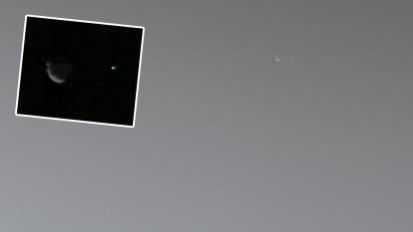In a groundbreaking achievement, NASA’s Curiosity rover has captured a stunning view of the surface of Mars, marking the first time that Earth and the Martian moon Phobos have been photographed together. This remarkable image, taken on September 5, shows Earth setting in the Martian night sky as Phobos rises nearby. The stunning view was captured by Curiosity’s Mast Camera (Mastcam) and then shared by NASA on September 13.
The image consists of five short exposures and twelve long exposures, providing a clear view of the rocky Martian terrain in the foreground, while Earth and Phobos are visible in the upper right. NASA officials highlighted the significance of the moment, stating: “It is the first time that an image of the two celestial bodies has been captured together from the surface of Mars.”
In the released image, a box identifies Phobos on the left and Earth on the right. NASA added that from the rover’s perspective, “the box area would be about half the width of a thumb held at arm’s length.”
Phobos, the larger of Mars’ two moons, is named after the Greek god of fear. Its smaller companion, Deimos, orbits farther away. Phobos’ orbit around Mars brings it within 6,000 kilometers of the planet’s surface, making it the closest natural satellite to its parent body in the solar system. However, Phobos is slowly moving closer to Mars, coming closer at a rate of about 1.8 meters every century. Scientists predict that the moon will either crash into Mars or disintegrate in about 50 million years because of this gradual approach.
The Curiosity rover, which landed in Gale Crater in August 2012, has been exploring Mars for more than a decade. The photo of Earth and Phobos was taken during the 4,295th Martian day (sol) of the rover’s mission. A Martian sol is slightly longer than an Earth day, lasting about 24 hours and 40 minutes.
The foreground of the image captures a Martian rock formation called Texoli, a hill located at the bottom of Mount Sharp, inside Gale Crater. Curiosity has been ascending this 5-kilometer-high mountain since 2014 on its mission to study the geological history of Mars and gain insights into the planet’s past.
This historic photograph adds another milestone to Curiosity’s legacy of scientific achievements on the Red Planet.
Disclaimer:
The information contained in this post is for general information purposes only. We make no representations or warranties of any kind, express or implied, about the completeness, accuracy, reliability, suitability or availability with respect to the website or the information, products, services, or related graphics contained on the post for any purpose.
We respect the intellectual property rights of content creators. If you are the owner of any material featured on our website and have concerns about its use, please contact us. We are committed to addressing any copyright issues promptly and will remove any material within 2 days of receiving a request from the rightful owner.

